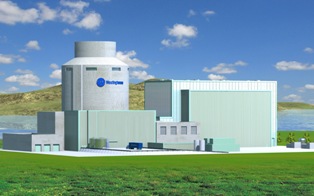 Following design certification by American regulators the Nuclear Regulatory Commission (NRC) in 2005 and certification of compliance by the European Utility Requirements (EUR) organisation, the AP1000 pressurized water reactor design has also been submitted to UK authorities for approval. Chinese authorities have approved the design such that site preparation work could begin within a few months.
Following design certification by American regulators the Nuclear Regulatory Commission (NRC) in 2005 and certification of compliance by the European Utility Requirements (EUR) organisation, the AP1000 pressurized water reactor design has also been submitted to UK authorities for approval. Chinese authorities have approved the design such that site preparation work could begin within a few months.Now Westinghouse has submitted to the NRC modifications it says will reduce cost and financial risk to buyers, afford extra protection against large aircraft crash, improve instrumentation and control, and finalise details such as pipe layouts. One design change is to the reactor coolant system's pressurizer, which has been reduced in size to fit within a refined seismic design envelope. A conservative design envelope would mean that a full-scope seismic analysis would not be required for each build site.
A statement said that "The revision includes design changes requested by our customers and developed by Westinghouse as part of design finalization." Some of the changes relate to issues identified by EUR and customers.
Westinghouse said that the changes would generically resolve some of the issues the NRC would have when an American utility applies for a combined construction and operating license for an AP1000. Resolving these in advance would save time and money for all applicants.
Some 13,000 pages of documentation have been submitted to UK regulators, the Nuclear Installations Inspectorate (NII). Adrian Bull of Westinghouse told World Nuclear News that the document was based on the US design certification package with UK-specific amendments and a guide to direct UK regulators to the answers to specific questions they would have.
Preliminary work on that analysis could begin shortly, with detailed analysis beginning if AP1000 were included on the UK regulator's priority list of new nuclear reactors. Vendors have until 22 June to submit their applications.
Bull said that Westinghouse wanted to have "one and only one design" for AP1000 units anywhere in the world - barring site specifics and differences necessary for 50 Hz or 60 Hz electricity generation. He said that he expected to liaise frequently with NII to demonstrate compliance during the three-year assessment.
However, Bull expected a formal contract regarding the four AP1000 units to be built at Sanmen and Haiyang in China within "a few weeks," adding that site preparation could begin a few weeks after that.
Bull explained to WNN that he wasn't concerned that design changes were being made in the USA, while Chinese units were almost ready for the start of construction. He said that this point, before any AP1000s have been built, was a sort of 'honeymoon' where there was still scope for minor design changes. He was confident that any amendments to Chinese units necessary to keep their design in line with units abroad would not be a problem and could be carried out during final preparation and construction.
The Chinese units would be the first AP1000s to generate electricity, the first coming online before the end of 2013 while possible US and UK units could start in 2014 and 2017.
Further information
Westinghouse
US Nuclear Regulatory Commission
UK Health and Safety Executive Nuclear Directorate
WNA's Nuclear Power in China information paper
WNA's Nuclear Power in the United Kingdom information paper
WNA's US Nuclear Power Industry information paper
WNN: US and Chinese regulators cooperate
WNN: European utilities certify Westinghouse's AP1000
WNN: Light shed on Chinese advanced reactor decisions




_18570.jpg)
_16159.jpg)
_18938.jpg)
_33584.jpg)





